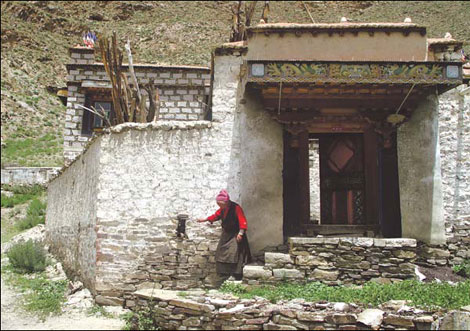
Lhoka Prefecture is home to many "firsts", such as the first Tibetan palace Yambulakang. (Source: China Daily/ Asia News Photo/Yu Zhiyong )
Nedong county, southeast of Lhasa, is an oasis of tranquility and home to the region's first palace as also its first village.
Riding an early morning bus with a dozen Tibetans in Nedong county feels surreal while listening to them making small talk in their own language feels even more unreal. While the morning ride is commonplace for the locals going about their everyday chores, it is a brand new experience for an outsider like me in the very heart of Tibet Autonomous Region.
August is a harvest season in Tibet, and the weather is the most pleasant. The cool climes offer a perfect escape from the heat of other parts of the country. Mysterious Tibet becomes even more attractive to travelers.
Hordes of tourists from home and abroad can be seen everywhere from the crowded capital city Lhasa to the sparsely populated western Nagri area. Hotel rates as well as prices of admission tickets to popular tourist draws, such as the Potala Palace, also begin to climb.
The oasis of tranquility in Nedong county of Lhoka Prefecture - an area to the southeast of Lhasa known as the cradle of Tibetan history and culture - offers a welcome respite. Although Nedong county, Lhoka's cultural and administrative center, is no more than 200 kilometers from Lhasa and about 100 km from the region's major airport, it is not known to many tourists.
Indeed, driving half an hour to the south along the two-lane asphalt road, which leads to the China-India border area, I do not see a single tour bus.
When the bus arrives at its final stop, only a handful of visitors can be seen and some are already trudging along the steep mountain path and halfway to their final destination.

A distinct Tibetan-style brick house in Yarlung Suoka, the region's first village. (Source: China Daily/Qi Xiao)
Yambulakang, the first-ever Tibetan palace
Perched precariously on the top of Mount Tashitseri overlooking the Yarlung River valley, considered the place of origin of Tibetan civilization, the palace was built more than 2,000 years ago by Nyatri Tsenpo, literally "King on the Neck", the first Tibetan king.
Legend has it that, one day, a strange-looking young man descended on the valley. When the tribal leaders asked him where he had come from, he just kept pointing to the sky as he could not understand them. The chieftains decided he had been sent from heaven, hoisted him on their necks and crowned him Nyatri ("neck" in Tibetan) Tsenpo ("king").
Historians later said Nyatri Tsenpo was actually from Bomi county in southeastern Tibet.
For those looking for magnificence, the first impression of this palace can be quite disappointing. One is apt to wonder how this three-story structure could become home to Tibetan kings and later also served as the summer palace for the mighty Songtsen Gampo and his wife Princess Wencheng.
A local peddler, who declines to reveal his name, becomes philosophical as he ponders this question.
"Everybody jostles into the Potala Palace, which is perfectly understandable given its grandeur and status," he says. "But the Potala, and various later palaces for that matter, are in fact just a series of Yambulakangs."
Visitors will quickly recognize Yambulakang's strategic location - it is easy to defend and well-positioned to withstand the frequent mudslides that used to plague the Yarlung River valley - and marvel at the wisdom of Nyatri Tsenpo. No wonder he was able to unite the warring tribes in this area and become king.

